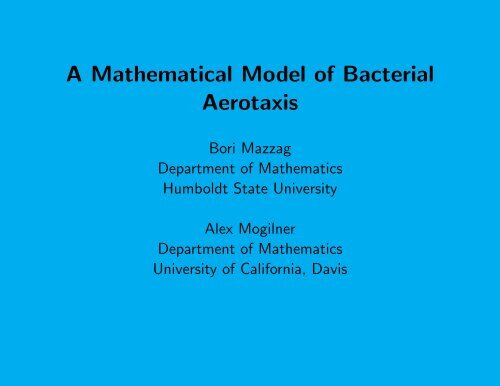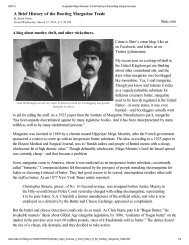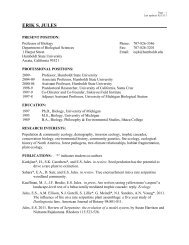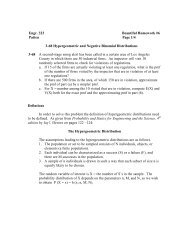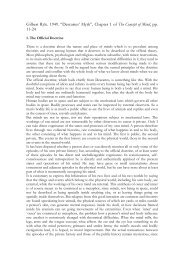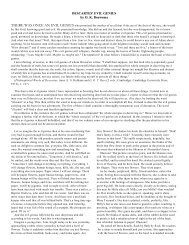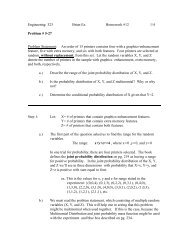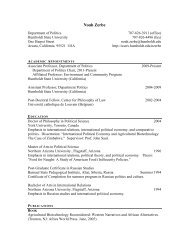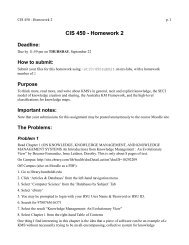A Mathematical Model of Bacterial Aerotaxis - Humboldt State ...
A Mathematical Model of Bacterial Aerotaxis - Humboldt State ...
A Mathematical Model of Bacterial Aerotaxis - Humboldt State ...
You also want an ePaper? Increase the reach of your titles
YUMPU automatically turns print PDFs into web optimized ePapers that Google loves.
A <strong>Mathematical</strong> <strong>Model</strong> <strong>of</strong> <strong>Bacterial</strong><br />
<strong>Aerotaxis</strong><br />
Bori Mazzag<br />
Department <strong>of</strong> Mathematics<br />
<strong>Humboldt</strong> <strong>State</strong> University<br />
Alex Mogilner<br />
Department <strong>of</strong> Mathematics<br />
University <strong>of</strong> California, Davis
• Chemotaxis and <strong>Aerotaxis</strong><br />
Outline
• Chemotaxis and <strong>Aerotaxis</strong><br />
Outline<br />
• Pattern formation in aerotaxis experiments<br />
(Zhulin et al. 1996)
• Chemotaxis and <strong>Aerotaxis</strong><br />
Outline<br />
• Pattern formation in aerotaxis experiments<br />
(Zhulin et al. 1996)<br />
• Our model
• Chemotaxis and <strong>Aerotaxis</strong><br />
Outline<br />
• Pattern formation in aerotaxis experiments<br />
(Zhulin et al. 1996)<br />
• Our model<br />
• Results
• Chemotaxis and <strong>Aerotaxis</strong><br />
Outline<br />
• Pattern formation in aerotaxis experiments<br />
(Zhulin et al. 1996)<br />
• Our model<br />
• Results<br />
• Significance and interpretation <strong>of</strong> our results
Concentration<br />
Conventional Chemotaxis<br />
t=t 0<br />
t= t 0 + Δ t<br />
Space
Chemotaxis and <strong>Aerotaxis</strong><br />
concentration<br />
chemotaxis<br />
aerotaxis<br />
Chemotaxis<br />
many attractants and repellents<br />
effector need not be metabolized<br />
external effector concentrations<br />
are monitored<br />
signaling:<br />
Tar, Tsr, Trg, Tap<br />
space<br />
<strong>Aerotaxis</strong><br />
oxygen is attractant and<br />
repellent<br />
oxygen is metabolized<br />
energy taxis − internal state<br />
monitored<br />
signaling: Tsr, Aer
Adaptation in conventional chemotaxis<br />
Turning frequency<br />
add attractant<br />
remove<br />
attractant<br />
(Figure based on Bray, 1992)<br />
Fast excitation (phosphorylation)<br />
Slow adaptation (methylation)
Adaptation in conventional chemotaxis<br />
Turning frequency<br />
add attractant<br />
remove<br />
attractant<br />
(Figure based on Bray, 1992)<br />
Fast excitation (phosphorylation)<br />
Slow adaptation (methylation)<br />
observable
Adaptation in conventional chemotaxis<br />
Turning frequency<br />
add attractant<br />
remove<br />
attractant<br />
(Figure based on Bray, 1992)<br />
Fast excitation (phosphorylation)<br />
Slow adaptation (methylation)<br />
observable<br />
serves as memory
Adaptation in conventional chemotaxis<br />
Turning frequency<br />
add attractant<br />
remove<br />
attractant<br />
(Figure based on Bray, 1992)<br />
Fast excitation (phosphorylation)<br />
Slow adaptation (methylation)<br />
observable<br />
serves as memory<br />
allows sensing in a wide range<br />
<strong>of</strong> concentrations
Adaptation in conventional chemotaxis<br />
Turning frequency<br />
add attractant<br />
remove<br />
attractant<br />
(Figure based on Bray, 1992)<br />
Fast excitation (phosphorylation)<br />
Slow adaptation (methylation)<br />
observable<br />
serves as memory<br />
allows sensing in a wide range<br />
<strong>of</strong> concentrations<br />
methylation based
Adaptation in conventional chemotaxis<br />
Turning frequency<br />
add attractant<br />
remove<br />
attractant<br />
(Figure based on Bray, 1992)<br />
Fast excitation (phosphorylation)<br />
Slow adaptation (methylation)<br />
observable<br />
serves as memory<br />
allows sensing in a wide range<br />
<strong>of</strong> concentrations<br />
methylation based<br />
slow (1-3 seconds)
Keller-Segel chemotaxis model
Keller-Segel chemotaxis model<br />
∂b +<br />
∂t<br />
∂b− ∂t<br />
+ v∂b+<br />
∂x = σ− b − − σ + b +<br />
− v∂b−<br />
∂x = σ+ b + − σ − b −<br />
(1)<br />
(2)
Keller-Segel chemotaxis model<br />
∂b +<br />
∂t<br />
∂b− ∂t<br />
+ v∂b+<br />
∂x = σ− b − − σ + b +<br />
− v∂b−<br />
∂x = σ+ b + − σ − b −<br />
Let b = b + + b− , J(x, t) = v(b + (x, t) − b− (x, t)),<br />
σ0 = 1<br />
2 (σ+ + σ− ), ∆σ = 1<br />
2 (σ+ − σ− ).<br />
(1)<br />
(2)
Keller-Segel chemotaxis model<br />
∂b +<br />
∂t<br />
∂b− ∂t<br />
+ v∂b+<br />
∂x = σ− b − − σ + b +<br />
− v∂b−<br />
∂x = σ+ b + − σ − b −<br />
Let b = b + + b− , J(x, t) = v(b + (x, t) − b− (x, t)),<br />
σ0 = 1<br />
2 (σ+ + σ− ), ∆σ = 1<br />
2 (σ+ − σ− ). By making the<br />
substitutions and adding 1 and 2, we get the equations:<br />
(1)<br />
(2)<br />
bt = −Jx<br />
(3)<br />
1<br />
Jt + J =<br />
2σ0<br />
1<br />
(−v<br />
2σ0<br />
2 bx + 2∆σvb) (4)
In small spatial gradients we can solve for J:<br />
J ≈ 1 2 ∂b<br />
(−v<br />
2σ0 ∂x<br />
+ 2∆σvb)
In small spatial gradients we can solve for J:<br />
J ≈ 1 2 ∂b<br />
(−v<br />
2σ0 ∂x<br />
+ 2∆σvb)<br />
Leading to the Keller-Segel (1970) equation:<br />
∂b<br />
∂t<br />
≈ ∂<br />
∂x (µ∂b<br />
∂x<br />
− χb) (5)
In small spatial gradients we can solve for J:<br />
J ≈ 1 2 ∂b<br />
(−v<br />
2σ0 ∂x<br />
+ 2∆σvb)<br />
Leading to the Keller-Segel (1970) equation:<br />
with<br />
(Grünbaum, 1999)<br />
∂b<br />
∂t<br />
≈ ∂<br />
∂x (µ∂b<br />
∂x<br />
µ = v2<br />
2σ0<br />
χ = v∆σ<br />
σ0<br />
− χb) (5)
Temporal assay with Azospirillum brazilense<br />
(s ) −1<br />
Reversal frequency<br />
0.7<br />
0.6<br />
0.5<br />
0.4<br />
0.3<br />
0.2<br />
0.1<br />
0%<br />
oxygen<br />
0.5%<br />
oxygen<br />
30 60 90 120<br />
Time(s)<br />
21%<br />
oxygen
−1<br />
Reversal frequency (s )<br />
0.7<br />
0.1<br />
Membrane potential and turning frequency<br />
0%<br />
oxygen<br />
0.5%<br />
oxygen<br />
30 60<br />
Time (s)<br />
90<br />
21%<br />
oxygen<br />
120
−1<br />
Reversal frequency (s )<br />
0.7<br />
0.1<br />
Membrane potential and turning frequency<br />
0%<br />
oxygen<br />
0.5%<br />
oxygen<br />
30 60<br />
Time (s)<br />
90<br />
21%<br />
oxygen<br />
120<br />
Electrode potential (mV)<br />
−80<br />
−60<br />
0.5 %<br />
1%<br />
5%<br />
25 50<br />
Time (min)<br />
0.5%
Capillary size:<br />
50 × 2 × 0.1mm<br />
Oxygen concentration in band:<br />
0.3 − 0.5µM<br />
Band width: 0.2 mm<br />
Time <strong>of</strong> band formation:<br />
50 sec - 3 min<br />
Spatial assay
Capillary size:<br />
50 × 2 × 0.1mm<br />
Oxygen concentration in band:<br />
0.3 − 0.5µM<br />
Band width: 0.2 mm<br />
Time <strong>of</strong> band formation:<br />
50 sec - 3 min<br />
Spatial assay
8<br />
7<br />
6<br />
5<br />
4<br />
3<br />
2<br />
1<br />
0<br />
−1<br />
Dashed line:path <strong>of</strong> bacteria<br />
Solid line: turning frequency<br />
−2<br />
0 1 2 3 4 5 6 7 8 9 10<br />
Time<br />
Monte-Carlo simulation
8<br />
7<br />
6<br />
5<br />
4<br />
3<br />
2<br />
1<br />
0<br />
−1<br />
Dashed line:path <strong>of</strong> bacteria<br />
Solid line: turning frequency<br />
−2<br />
0 1 2 3 4 5 6 7 8 9 10<br />
Time<br />
Monte-Carlo simulation<br />
constant velocity, v<br />
turning frequency<br />
in band: σ = 0<br />
cell leaves band<br />
at random time, τ<br />
outside the band<br />
σ jumps to c<br />
characteristic time<br />
<strong>of</strong> adaptation: ta<br />
adaptation: σ = ce −t−τ<br />
ta
<strong>Model</strong>ing goals and assumptions<br />
Goal: create a mathematical model which reproduces sharp<br />
aerotactic band formation in spatial assays with Azospirillum<br />
brazilense
<strong>Model</strong>ing goals and assumptions<br />
Goal: create a mathematical model which reproduces sharp<br />
aerotactic band formation in spatial assays with Azospirillum<br />
brazilense<br />
Assumptions:<br />
• bacterial swimming is one-dimensional<br />
and it has constant velocity
<strong>Model</strong>ing goals and assumptions<br />
Goal: create a mathematical model which reproduces sharp<br />
aerotactic band formation in spatial assays with Azospirillum<br />
brazilense<br />
Assumptions:<br />
• bacterial swimming is one-dimensional<br />
and it has constant velocity<br />
• no bacterial reproduction
<strong>Model</strong>ing goals and assumptions<br />
Goal: create a mathematical model which reproduces sharp<br />
aerotactic band formation in spatial assays with Azospirillum<br />
brazilense<br />
Assumptions:<br />
• bacterial swimming is one-dimensional<br />
and it has constant velocity<br />
• no bacterial reproduction<br />
• oxygen concentration is fixed at the open end <strong>of</strong> the capillary
<strong>Model</strong>ing goals and assumptions<br />
Goal: create a mathematical model which reproduces sharp<br />
aerotactic band formation in spatial assays with Azospirillum<br />
brazilense<br />
Assumptions:<br />
• bacterial swimming is one-dimensional<br />
and it has constant velocity<br />
• no bacterial reproduction<br />
• oxygen concentration is fixed at the open end <strong>of</strong> the capillary<br />
• no slow adaptation
∂r<br />
∂t<br />
∂l<br />
∂t<br />
Our model<br />
= −v ∂r<br />
∂x − frlr + flrl<br />
= v ∂l<br />
∂x + frlr − flrl
∂r<br />
∂t<br />
∂l<br />
∂t<br />
Our model<br />
= −v ∂r<br />
∂x − frlr + flrl<br />
= v ∂l<br />
∂x + frlr − flrl<br />
∂L<br />
∂t = D∂2 L<br />
− k(r + l)<br />
∂x2
∂r<br />
∂t<br />
∂l<br />
∂t<br />
Our model<br />
= −v ∂r<br />
∂x − frlr + flrl<br />
= v ∂l<br />
∂x + frlr − flrl<br />
∂L<br />
∂t = D∂2 L<br />
− k(r + l)<br />
∂x2 r(0, t) = l(0, t)<br />
r(l, t) = l(l, t)<br />
L(0, t) = L0<br />
∂L<br />
�<br />
�<br />
� = 0<br />
∂x x=l
Proton Motive Force (PMF)<br />
High left−to−right<br />
turning rate<br />
~<br />
Lmin No turning<br />
L min<br />
L max<br />
~<br />
Lmax Turning rates<br />
High right−to−left<br />
turning rate
Proton Motive Force (PMF)<br />
High left−to−right<br />
turning rate<br />
~<br />
Lmin No turning<br />
L min<br />
L max<br />
~<br />
Lmax Turning rates<br />
High right−to−left<br />
turning rate<br />
~<br />
L max<br />
L max<br />
L min<br />
~<br />
L min<br />
C c c C<br />
C C c c<br />
C<br />
C<br />
flr<br />
frl
Proton Motive Force (PMF)<br />
High left−to−right<br />
turning rate<br />
~<br />
Lmin No turning<br />
L min<br />
L max<br />
frl =<br />
~<br />
Lmax Turning rates<br />
High right−to−left<br />
turning rate<br />
⎧<br />
⎪⎨<br />
⎪⎩<br />
~<br />
L max<br />
L max<br />
L min<br />
~<br />
L min<br />
C c c C<br />
C C c c<br />
C, L < ˜ Lmin<br />
c, ˜ Lmin < L < Lmin<br />
c, Lmin < L < Lmax<br />
C, Lmax < L < ˜ Lmax<br />
C, ˜ Lmax < L<br />
C<br />
C<br />
flr<br />
frl
Parameters and nondimensionalization<br />
Measurement Dim. quantity Non-dim. value<br />
Length 2 mm 1<br />
Time 10 sec 1<br />
Oxygen conc. 1 µM<br />
<strong>Bacterial</strong> conc.<br />
ml<br />
2 · 10<br />
1<br />
7cells<br />
Speed<br />
ml<br />
40<br />
1<br />
µm<br />
0.2<br />
sec<br />
−9 m2<br />
sec<br />
Diffusion coeff. 2 · 10 0.01<br />
Turning frequency 1sec−1 10<br />
4 · 10−3 Rate <strong>of</strong> O2 consump. 3 · 10 −11 µM<br />
(cell)(sec)
Numerical results<br />
Invasion <strong>of</strong> oxygen: x � √ Dt, Escape <strong>of</strong> bacteria: x � vt
Numerical results<br />
Invasion <strong>of</strong> oxygen: x � √ Dt, Escape <strong>of</strong> bacteria: x � vt<br />
t � D<br />
v 2 � 5 sec, x � vt0 � 100µm → ∆x = 50µm, ∆t = 0.01
2.5<br />
2<br />
1.5<br />
1<br />
0.5<br />
Bacteria: solid line, oxygen: dotted line, t=0 s<br />
0<br />
0 5 10 15 20 25 30 35 40<br />
Numerical results<br />
Invasion <strong>of</strong> oxygen: x � √ Dt, Escape <strong>of</strong> bacteria: x � vt<br />
t � D<br />
v 2 � 5 sec, x � vt0 � 100µm → ∆x = 50µm, ∆t = 0.01
2.5<br />
2<br />
1.5<br />
1<br />
0.5<br />
Bacteria: solid line, oxygen: dotted line, t=0 s<br />
0<br />
0 5 10 15 20 25 30 35 40<br />
Numerical results<br />
0<br />
0 5 10 15 20 25 30 35 40<br />
Invasion <strong>of</strong> oxygen: x � √ Dt, Escape <strong>of</strong> bacteria: x � vt<br />
t � D<br />
v 2 � 5 sec, x � vt0 � 100µm → ∆x = 50µm, ∆t = 0.01<br />
3.5<br />
3<br />
2.5<br />
2<br />
1.5<br />
1<br />
0.5<br />
Bacteria: solid line, oxygen: dotted line, t=5 s
7<br />
6<br />
5<br />
4<br />
3<br />
2<br />
1<br />
Bacteria: solid line, oxygen: dotted line, t=15 s<br />
0<br />
0 5 10 15 20 25 30 35 40
7<br />
6<br />
5<br />
4<br />
3<br />
2<br />
1<br />
Bacteria: solid line, oxygen: dotted line, t=15 s<br />
0<br />
0 5 10 15 20 25 30 35 40<br />
14<br />
12<br />
10<br />
8<br />
6<br />
4<br />
2<br />
Bacteria: solid line, oxygen: dotted line, t=50 s<br />
0<br />
0 5 10 15 20 25 30 35 40
7<br />
6<br />
5<br />
4<br />
3<br />
2<br />
1<br />
Bacteria: solid line, oxygen: dotted line, t=15 s<br />
0<br />
0 5 10 15 20 25 30 35 40<br />
18<br />
16<br />
14<br />
12<br />
10<br />
8<br />
6<br />
4<br />
2<br />
Bacteria: solid line, oxygen: dotted line, t=180 s<br />
0<br />
0 5 10 15 20 25 30 35 40<br />
14<br />
12<br />
10<br />
8<br />
6<br />
4<br />
2<br />
Bacteria: solid line, oxygen: dotted line, t=50 s<br />
0<br />
0 5 10 15 20 25 30 35 40
Numerical experiments with ˜ Lmax and ˜ Lmin<br />
10<br />
8<br />
6<br />
4<br />
2<br />
10<br />
8<br />
6<br />
4<br />
2<br />
~<br />
L max<br />
~<br />
L max<br />
=4%<br />
=7%<br />
~<br />
Lmin<br />
=0%<br />
0.5 1 1.5 2<br />
~<br />
Lmin<br />
=0.5%<br />
~<br />
Lmin<br />
=0%<br />
~<br />
L max<br />
=7%<br />
0.5 1 1.5 2
10<br />
9<br />
8<br />
7<br />
6<br />
5<br />
4<br />
3<br />
2<br />
1<br />
d<br />
Quasi steady state solution<br />
h<br />
0.5 1 1.5 2<br />
B<br />
b 0<br />
� L0<br />
kb0<br />
• d ≈<br />
d ≈ 0.8 mm for L0 = 0.2 and<br />
d ≈ 1.7 mm for L0 = 1<br />
• h ≈ 2Lmax<br />
�<br />
kb0<br />
kb0 L0<br />
h ≈ 0.4mm for L0 = 0.2 and<br />
h ≈ 0.2mm for L0 = 1
Summary <strong>of</strong> results<br />
• model supports the notion <strong>of</strong> a novel gradient sensing mechanism
Summary <strong>of</strong> results<br />
• model supports the notion <strong>of</strong> a novel gradient sensing mechanism<br />
• distance between the band and the meniscus, d is predicted to<br />
depend on external oxygen concentration, L0
Summary <strong>of</strong> results<br />
• model supports the notion <strong>of</strong> a novel gradient sensing mechanism<br />
• distance between the band and the meniscus, d is predicted to<br />
depend on external oxygen concentration, L0<br />
• width <strong>of</strong> bacterial band, h, is independent <strong>of</strong> L0 in steady state and<br />
dependent on L0 in the quasi steady state
Summary <strong>of</strong> results<br />
• model supports the notion <strong>of</strong> a novel gradient sensing mechanism<br />
• distance between the band and the meniscus, d is predicted to<br />
depend on external oxygen concentration, L0<br />
• width <strong>of</strong> bacterial band, h, is independent <strong>of</strong> L0 in steady state and<br />
dependent on L0 in the quasi steady state<br />
• numerical values <strong>of</strong> d, h, bacterial density and time <strong>of</strong> pattern<br />
formation agrees with experimental values
Summary <strong>of</strong> results<br />
• model supports the notion <strong>of</strong> a novel gradient sensing mechanism<br />
• distance between the band and the meniscus, d is predicted to<br />
depend on external oxygen concentration, L0<br />
• width <strong>of</strong> bacterial band, h, is independent <strong>of</strong> L0 in steady state and<br />
dependent on L0 in the quasi steady state<br />
• numerical values <strong>of</strong> d, h, bacterial density and time <strong>of</strong> pattern<br />
formation agrees with experimental values<br />
• model allows estimates for ˜ Lmax and ˜ Lmin which are experimentally<br />
difficult to obtain
Slow adaptation<br />
Fast adapation<br />
Chemotactic models<br />
Keller−Segel equation<br />
Advection equation<br />
Small spatial gradient<br />
No tractable model<br />
Our model<br />
Large spatial gradient
z<br />
z<br />
Receptor model<br />
Taylor and Johnson<br />
(1998)<br />
fast<br />
slow<br />
PMF<br />
PMF
Thank you!<br />
Bori Mazzag<br />
Mathematics Department<br />
<strong>Humboldt</strong> <strong>State</strong> University<br />
1 Harpst St, Arcata CA 95521<br />
(707) - 826 5349<br />
bcm9@humboldt.edu
Equilibrium position for fast moving part: ˜zf = z0 f + c1p<br />
For slow moving part: ˜zs = z0 s + c1p = z0 f − ∆z + c1p<br />
Proton motive force: p = ±kt + c0
Equilibrium position for fast moving part: ˜zf = z0 f + c1p<br />
For slow moving part: ˜zs = z0 s + c1p = z0 f − ∆z + c1p<br />
Proton motive force: p = ±kt + c0<br />
System <strong>of</strong> equations describing position <strong>of</strong> parts:<br />
dzs<br />
dt<br />
zf ≈ ˜zf(p(t))<br />
= 1<br />
τ (˜zs(p(t) − zs)
Equilibrium position for fast moving part: ˜zf = z0 f + c1p<br />
For slow moving part: ˜zs = z0 s + c1p = z0 f − ∆z + c1p<br />
Proton motive force: p = ±kt + c0<br />
System <strong>of</strong> equations describing position <strong>of</strong> parts:<br />
Solution:<br />
dzs<br />
dt<br />
zf ≈ ˜zf(p(t))<br />
= 1<br />
τ (˜zs(p(t) − zs)<br />
zf = z 0 f + c0c1 ± c1kt<br />
zs = z 0 f + c1c0 − ∆z ± c1k(t − τ) + z0e −t/τ<br />
z 0 f : ground state (fast) z0 s: ground state (slow) τ: adaptation time


